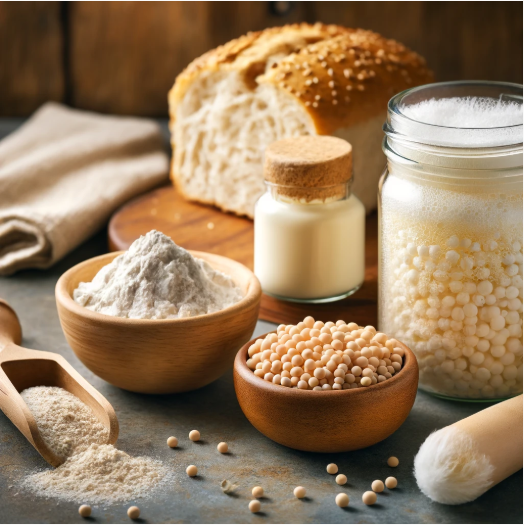If you’re diving into the world of bread making, one of the first things you’ll encounter is yeast—the essential ingredient that makes your dough rise. But with so many types of yeast available, it’s easy to get confused. Dry yeast, fresh yeast, natural yeast… what’s the difference, and which one should you use?
In this article, we’ll break down the main types of yeast, explain how they work, and help you decide which one is best for your bread-baking goals.
- What Is Yeast?
Yeast is a single-celled microorganism that feeds on sugars and produces carbon dioxide and alcohol through fermentation. In bread making, the carbon dioxide gets trapped in the dough, causing it to rise and develop flavor and texture. Yeast also contributes to the crust and crumb color and enhances the aroma of the finished loaf.
There are three main types of yeast used in baking:
- Dry Yeast (Active Dry and Instant)
- Fresh Yeast (also called Cake or Compressed Yeast)
- Natural Yeast (Sourdough Starter)
Let’s explore each in detail.
- Dry Yeast
Dry yeast is the most commonly used yeast for home bakers and is available in two forms: active dry yeast and instant yeast.
- Active Dry Yeast: This yeast comes in small granules and needs to be activated before use. To do this, you dissolve it in warm water (around 105°F to 110°F / 40°C to 43°C) and let it sit for 5–10 minutes until it becomes foamy. Once it’s activated, you can add it to your dough mixture.
- Instant Yeast (also known as rapid-rise or quick-rise yeast): This yeast is milled into finer particles and doesn’t need to be dissolved in water. You can add it directly to the dry ingredients. It also rises faster than active dry yeast, making it convenient for quicker recipes.
Pros of Dry Yeast:
- Long shelf life
- Easy to store and measure
- Widely available
- Reliable and consistent results
Cons:
- Instant yeast can work too quickly, reducing flavor development
- Active dry yeast requires a proofing step, which adds time
Best Uses: Everyday sandwich breads, quick artisan loaves, enriched doughs like cinnamon rolls or challah.
- Fresh Yeast
Fresh yeast, also known as cake yeast or compressed yeast, comes in a moist, crumbly block. It’s more perishable than dry yeast and usually needs to be stored in the refrigerator. It has a creamy, mild flavor and is often used in professional bakeries due to its fast-acting fermentation.
To use fresh yeast, crumble it into warm water or milk and mix it until it dissolves completely. Unlike dry yeast, it begins working immediately and doesn’t need proofing time.
Pros of Fresh Yeast:
- Mild, smooth flavor
- Fast activation
- Preferred by many artisan bakers
Cons:
- Short shelf life (about 2 weeks refrigerated)
- Less commonly available in supermarkets
- Requires accurate measurement and storage
Best Uses: European-style breads, bakery-style loaves, recipes where a subtle yeast flavor is desired.
Substitution Tip: If your recipe calls for one type of yeast but you only have another, here’s how to substitute:
- 1 part fresh yeast = 0.4 parts active dry yeast
- 1 part fresh yeast = 0.33 parts instant yeast
Example: If a recipe calls for 30g fresh yeast, use about 12g of active dry or 10g of instant yeast.
- Natural Yeast (Sourdough Starter)
Natural yeast isn’t purchased in a packet or block—it’s cultivated at home or passed down as a living culture. Known as a sourdough starter, this wild yeast is made by fermenting flour and water over several days, capturing wild yeast and beneficial bacteria from the environment.
Natural yeast creates a tangy flavor and chewy texture that’s distinctive in sourdough and other rustic breads. It requires regular feeding and maintenance, but for many bakers, it’s worth the extra effort.
Pros of Natural Yeast:
- Rich, complex flavor
- Long fermentation improves texture and shelf life
- No need to buy yeast if you maintain your starter
- Can be more digestible due to lactic acid bacteria
Cons:
- Needs daily or weekly feeding and care
- Takes longer to rise
- More variable results compared to commercial yeast
Best Uses: Artisan sourdough, rustic boules, ciabatta, rye bread, long-fermentation loaves.
- Which Yeast Should You Use?
Choosing the right yeast depends on your goals, schedule, and the type of bread you’re baking:
- For beginners or quick baking sessions: Instant yeast is a great place to start.
- For classic breads with flavor and a bit of patience: Active dry yeast is a solid option.
- For bakery-style loaves: Fresh yeast delivers smooth, subtle results if you can find it.
- For deep flavor and traditional methods: Natural yeast (sourdough starter) is the gold standard.
- Tips for Working with Any Yeast
- Always check expiration dates, especially for dry and fresh yeast.
- Store dry yeast in the fridge or freezer to extend shelf life.
- Keep natural yeast (starter) in a clean jar, feed it regularly, and watch for any signs of spoilage.
- Don’t kill your yeast! Water that’s too hot (above 120°F / 49°C) can kill it. Aim for warm, not hot.
Now that you understand the differences between dry, fresh, and natural yeast, you can bake with confidence and choose the type that best suits your recipe and lifestyle.
